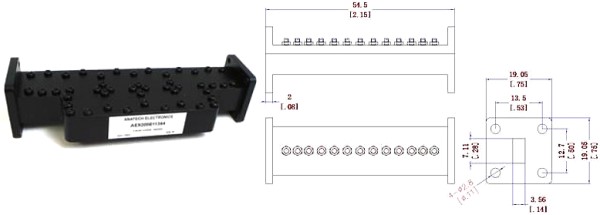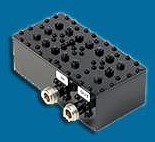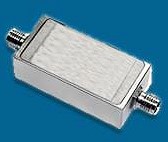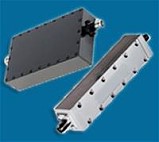|

Anatech Electronics, an RF and microwave filter company, has introduced a new
line of suspended stripline and waveguide type RF filters. Sam Benzacar wrote as
part of Anatech's August newsletter about the continued debate over whether
exposure to cellphones causes cancer, diminished vision, etc. His short op-ed
entitled "Radiation
Hazard Battles Continue Unabated" is likely a response to the FCC's recent
declaration that RF energy at 5G mm-wave frequencies does not pose an increased health hazard
over existing technologies. Millimeter-wave energy is non-ionizing and does not penetrate the skin deeply enough to be an issue
at operational power levels.
Also included are a few news headlines related to Anatech's core business of designing
and manufacturing filters.
A Word from Sam Benzacar
 Radiation
Hazard Battles Continue Unabated
By Sam Benzacar
In the nearly 40 years I've been in the microwave industry, the most long-lasting,
contentious, and "agenda-driven" issue I've encountered concerns the potentially
damaging effects electromagnetic energy to humans. After hundreds of studies and
thousands of peer-reviewed journal articles, the issue remains as poisonous as ever.
In fact, the only issue of any kind in any discipline I can think of that has been
around for this long is whether vaccinations cause various medical issues, including
autism, the flu, and other diseases or conditions.
The difference between the latter and former is that while the junk-science-based
vaccination claims have been thoroughly debunked by massive statistical evidence,
there is no consensus about what, other than heating effects, electromagnetic energy
can do to harm the body. When asked for a definitive answer, most people involved
with the issue take the safe road: We just don't know. This leaves the door wide
open for speculation by virtually anyone and especially by those with a vested interest
in assuring the public that there's nothing to worry about and as well as those
who simply don't want ugly cell sites in their neighborhoods and use public safety
to defend their positions.
 The scientific community doesn't come off well,
either. For example, large studies conducted over the years showed no direct correlation
between RF energy and brain damage, changes to DNA, cancer, and other maladies.
Upon close inspection, the people conducting the studies have often had connections
to the wireless industry or have been funded by manufacturers or industry groups.
Some studies have been so seriously flawed that it's hard to believe that peer review
was even conducted. Many other studies showing a direct correlation, however, have
withstood intense inspection, and this list is growing, especially in some Scandinavian
countries. The scientific community doesn't come off well,
either. For example, large studies conducted over the years showed no direct correlation
between RF energy and brain damage, changes to DNA, cancer, and other maladies.
Upon close inspection, the people conducting the studies have often had connections
to the wireless industry or have been funded by manufacturers or industry groups.
Some studies have been so seriously flawed that it's hard to believe that peer review
was even conducted. Many other studies showing a direct correlation, however, have
withstood intense inspection, and this list is growing, especially in some Scandinavian
countries.
The latest onslaught from both sides of this position focuses on 5G and the need
to operate at millimeter-wave frequencies. As they have very limited range, huge
numbers of small cells will be needed to deliver the blindingly-fast data rates
and low latency carriers are promising. As these small base stations have started
to sprout in some cities, they're becoming hard to miss, a situation that will only
become more intense if "coverage everywhere" is to be achieved.
But this time, the naysayers won't have as much ammunition, as unlike at lower
frequencies, millimeter-wave energy doesn't penetrate the skin to significant depths,
making it more difficult to build a case that small cells in the neighborhood are
a health hazard. That's not likely to stop the outcry from the hundred-odd groups
throughout the country that belong to coalitions like Americans for Responsible
Technology. We can also expect new studies to appear that are dedicated to millimeter-wave
rather than RF and microwave frequencies.
Meanwhile, the wireless industry will continue to roll out 5G at a mad pace - and
we'll all be using it eventually. As for the answer to the question of health hazards,
the safe answer will continue to be "we just don't know."
 FCC: No Limits on RF Exposure Needed for 5G FCC: No Limits on RF Exposure Needed for 5G
The FCC has decided that 5G doesn't pose added health risks, so no new limits
on RF exposure will be required. FCC Chairman Ajit Pai maintains that current limits
are fine and enough to ensure public safety, after six years of review with the
FDA and other federal health and safety agencies. The exposure limits apply to handheld
devices, computers and cell towers, and span technology generations including 3G,
4G, and 5G. Pai's proposal also seeks to establish a uniform set of guidelines,
regardless of the wireless service of technology, for how to determine compliance
with the FCC's exposure standards.
 Are Wireless Carriers Throttling Bandwidth?
Of Course. Are Wireless Carriers Throttling Bandwidth?
Of Course.
Wireless carriers have never hidden the fact that they may on occasions slow
video traffic on their networks to avoid congestion, but according to researchers
from Northeastern University and the University of Massachusetts Amherst, they do
it everywhere, all the time. They conducted more than 650,000 tests in the US and
found that from early 2018 to early 2019, AT&T throttled Netflix Inc. 70% of
the time and YouTube 74% of the time, but not Amazon Prime Video. T-Mobile US Inc.
throttled Amazon Prime Video in about 51% of the tests.
 Fighter Pilot Cancer Rate Increasing Fighter Pilot Cancer Rate Increasing
Former fighter pilots are developing especially intrusive forms of cancer, and
some suspect it's from exposure to intense radar systems. "We are dropping like
flies in our 50s from aggressive cancers," retired Air Force Col. Eric Nelson, a
former F-15 weapons officer, told McClatchy. Nelson said aviators he flew with and
commanded have been diagnosed with prostate and esophageal cancer, lymphoma, and
lioblastomas at abnormal rates. Nelson also was diagnosed with prostate cancer at
age 48, three months after his retirement from the Air Force. Research into the
issue has produced varying conclusions but some suspect the increased cancer rates
are caused by proximity to high-power radars on the aircraft. Former pilots such
as Crosby are calling on the military to lower the age of cancer screenings for
pilots to 30 to catch the disease earlier.
 Pentagon Tests Radar-Equipped Balloons in U.S. Pentagon Tests Radar-Equipped Balloons in U.S.
Americans across the Midwest this summer are being subjected to surveillance
from above as the Pentagon experiments with the use of surveillance radars attached
to high-altitude balloons. Sierra Nevada Corporation was authorized by the Federal
Communications Commission (FCC) to send up to 25 balloons across six states to track
vehicles, according to The Guardian. U.S. Southern Command commissioned the project
for the stated purpose of creating a "persistence surveillance system" to deter
drug traffickers and perceived "homeland security threats."
Getting Ready for 5G:
Anatech Electronics introduce New Ka band 30.5 GHz Waveguide Band Pass Filter.
Featuring a center frequency of 30.5 GHz, a bandwidth of 1000 MHz, an Insertion
Loss 1 dB Max, and a Power Handling is 20 watts.

Anatech Electronics Introduces a New Line of Suspended Stripline and
Waveguide Type RF Filters
Check out Our Filter Products



Cavity Band Pass Filters
LC Band Pass Filters Cavity Bandstop/Notch Filter
About Anatech Electronics
Anatech Electronics, Inc. (AEI) specializes in the design and manufacture of
standard and custom RF and microwave filters and other passive components and subsystems
employed in commercial, industrial, and aerospace and applications. Products are
available from an operating frequency range of 10 kHz to 30 GHz and include cavity,
ceramic, crystal, LC, and surface acoustic wave (SAW), as well as power combiners/dividers,
duplexers and diplexers, directional couplers, terminations, attenuators, circulators,
EMI filters, and lightning arrestors. The company's custom products and capabilities
are available at www.anatechelectronics.com.
Contact:
Anatech Electronics, Inc. 70 Outwater Lane Garfield, NJ 07026 (973)
772-4242
sales@anatechelectronics.com
Posted August 22, 2019
|






























 The scientific community doesn't come off well,
either. For example, large studies conducted over the years showed no direct correlation
between RF energy and brain damage, changes to DNA, cancer, and other maladies.
Upon close inspection, the people conducting the studies have often had connections
to the wireless industry or have been funded by manufacturers or industry groups.
Some studies have been so seriously flawed that it's hard to believe that peer review
was even conducted. Many other studies showing a direct correlation, however, have
withstood intense inspection, and this list is growing, especially in some Scandinavian
countries.
The scientific community doesn't come off well,
either. For example, large studies conducted over the years showed no direct correlation
between RF energy and brain damage, changes to DNA, cancer, and other maladies.
Upon close inspection, the people conducting the studies have often had connections
to the wireless industry or have been funded by manufacturers or industry groups.
Some studies have been so seriously flawed that it's hard to believe that peer review
was even conducted. Many other studies showing a direct correlation, however, have
withstood intense inspection, and this list is growing, especially in some Scandinavian
countries.  FCC: No Limits on RF Exposure Needed for 5G
FCC: No Limits on RF Exposure Needed for 5G
 Are Wireless Carriers Throttling Bandwidth?
Of Course.
Are Wireless Carriers Throttling Bandwidth?
Of Course.  Fighter Pilot Cancer Rate Increasing
Fighter Pilot Cancer Rate Increasing
 Pentagon Tests Radar-Equipped Balloons in U.S.
Pentagon Tests Radar-Equipped Balloons in U.S.





